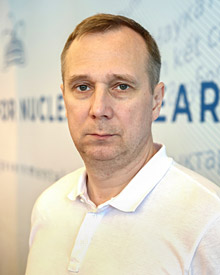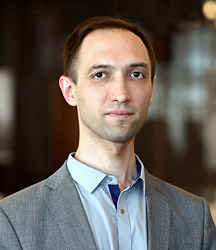
Electronic english version since 2022 |
The newspaper was founded in November 1957
| |
|
Number 23 (4671) |
At PAC meetings
Condensed Matter Physics: Lots of Projects
On 15-16 June, the 57th meeting of the Programme Advisory Committee for Condensed Matter Physics was held in Dubna in a mixed format.
 The programme of the meeting was intense. Chairman of the Committee D.Nagy reported on the implementation of the recommendations of the previous meeting of the PAC, L.Kostov introduced the resolution of the 133rd session of the Scientific Council and the decisions of the last meeting of the PAC. The staff members of FLNP, DLNP, LRB and FLNR made proposals to open new and prolong old projects and subprojects. The first speaker in this section of the meeting was FLNP Director Egor Lychagin. He gave a comment to the media of the Institute.
The programme of the meeting was intense. Chairman of the Committee D.Nagy reported on the implementation of the recommendations of the previous meeting of the PAC, L.Kostov introduced the resolution of the 133rd session of the Scientific Council and the decisions of the last meeting of the PAC. The staff members of FLNP, DLNP, LRB and FLNR made proposals to open new and prolong old projects and subprojects. The first speaker in this section of the meeting was FLNP Director Egor Lychagin. He gave a comment to the media of the Institute.
- We have decided to unite four themes that were previously developed independently, into one large infrastructure project "Pulsed neutron source and spectrometers". Within the framework of the new project, these four themes will be prolonged. I hope that such a union will allow us to improve the manageability of the scientific research process and to concentrate our human and material resources on the main tasks of this project. First of all, this is the safe operation of our reactor, the development of condensed matter physics using neutron scattering, the development of a new source that should replace the IBR-2 reactor in the near future.
Our work on the development of the new source in FLNP is presented in detail in the second report "Development of the IBR-2 research nuclear facility with a complex of cryogenic neutron moderators". Maxim Bulavin presented in detail the state in which we are today in his report "A new promising source of neutrons at JINR". We discuss development of the new pulsed neutron source based on a new fuel - neptunium nitride. This will allow us to improve the parameters of the operating reactor by a factor of about 10, to increase the neutron flux by a factor of 10 that in turn, promises to provide new technological possibilities in research with neutrons.
What is the status with obtaining another license for the operation of the reactor and with the replacement of heat exchangers?
- Currently, the reactor is in a state of prolonged shutdown. This is due to the fact that we are in the licensing process with the organization that oversees the use of nuclear facilities, Rostekhnadzor, in order to obtain a license to put our facility into operation. We have sent the appropriate package of documents to Rostekhnadzor, the documents have been sent to an expert organization that unfortunately for us, took eight months to complete its work instead of the three that we had planned. Today, we work with experts in very close cooperation, answering their questions, making the required changes to the documentation. We hope that this work will be completed in October. Afterwards, according to the regulations, Rostekhnadzor has the right to spend three months on making a decision on issuing a license. If everything goes relatively smoothly, then I hope, by the beginning of next year, we will receive this license to put the reactor into operation for the next nine years. Subsequently, we can turn on the reactor.
Since we still want to replace the heat exchangers, I talked about two scenarios in the report. In one case, we turn on the reactor immediately after the New Year, work all spring and in summer, during scheduled preventive maintenance, we replace heat exchangers. Afterwards, a little paper work with Rostekhnadzor and we start the reactor in autumn, I hope for the next nine years. In other case, the issuance of the license is delayed until the spring of next year, then there will be no point in turning on the reactor in summer, we immediately change the heat exchangers and the reactor starts operating in autumn with new heat exchangers.
The proposal to open two new projects was made by the staff members of LRB.
 "JINR Topical Plan has been renewed and in this regard, the structure of themes and projects of the Laboratory has slightly changed," Director of LRB A.N.Bugay comments. "We are presenting two large projects at the PAC. The first - on various aspects of radiobiological research: molecular, cellular, organismal effects of various radiations that are available at the Institute. This is a variety of programme research related to the investigation of DNA damage, chromosomal aberrations, mutations, various effects concerning both behavior and pathomorphology. Various effects regarding the action of cosmic radiation will be investigated that are related to the most important applications of radiation risk assessment for astronauts. In addition, there are investigations specifically focused on the applications of radiation therapy, the improvement of new techniques. The second project is more focused, let's say, on the physical and chemical part. It concerns the equipment of channels for research, with the provision of dosimetry, special facilities that are required by biologists. Data automation plays a special role, we work not only with experimental laboratories, but also with the Information Technology Laboratory, new information systems are developed. Naturally, groups on mathematical and computer modeling work, this is a very large pool of work that we traditionally develop. In addition, structural investigations of organic remains and remains of living organisms in meteorites are currently carried out - this is an application in the field of astrobiology, as well as investigations of radiation catalysis and the synthesis of prebiotic compounds that are the building blocks of life. This is the wide range of research that will be presented in our projects at this meeting.
"JINR Topical Plan has been renewed and in this regard, the structure of themes and projects of the Laboratory has slightly changed," Director of LRB A.N.Bugay comments. "We are presenting two large projects at the PAC. The first - on various aspects of radiobiological research: molecular, cellular, organismal effects of various radiations that are available at the Institute. This is a variety of programme research related to the investigation of DNA damage, chromosomal aberrations, mutations, various effects concerning both behavior and pathomorphology. Various effects regarding the action of cosmic radiation will be investigated that are related to the most important applications of radiation risk assessment for astronauts. In addition, there are investigations specifically focused on the applications of radiation therapy, the improvement of new techniques. The second project is more focused, let's say, on the physical and chemical part. It concerns the equipment of channels for research, with the provision of dosimetry, special facilities that are required by biologists. Data automation plays a special role, we work not only with experimental laboratories, but also with the Information Technology Laboratory, new information systems are developed. Naturally, groups on mathematical and computer modeling work, this is a very large pool of work that we traditionally develop. In addition, structural investigations of organic remains and remains of living organisms in meteorites are currently carried out - this is an application in the field of astrobiology, as well as investigations of radiation catalysis and the synthesis of prebiotic compounds that are the building blocks of life. This is the wide range of research that will be presented in our projects at this meeting.
Traditionally, the poster session was held online. The winners of the poster session were young FLNP researchers V.D.Zhaketov, "Proximity effects in superconducting and ferromagnetic heterostructures"; O.N.Lis, "Impact of high pressure on the crystal, magnetic structures and vibrational spectra of Van der Waals material"; A.Asadov, "Impact of high pressure on the crystal structure and vibrational spectra of layered perovskite-like Nd2Ti2O7".
Olga TARANTINA,
photo by Igor LAPENKO